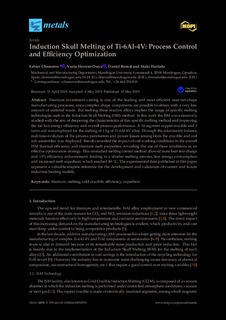| dc.rights.license | Attribution 4.0 International | * |
| dc.contributor.author | chamorro, xabier | |
| dc.contributor.author | Herrero-Dorca, Nuria | |
| dc.contributor.author | Bernal, Daniel | |
| dc.contributor.author | Hurtado, Iñaki | |
| dc.date.accessioned | 2019-06-27T14:19:06Z | |
| dc.date.available | 2019-06-27T14:19:06Z | |
| dc.date.issued | 2019 | |
| dc.identifier.issn | 2075-4701 | en |
| dc.identifier.other | https://katalogoa.mondragon.edu/janium-bin/janium_login_opac.pl?find&ficha_no=151028 | en |
| dc.identifier.uri | https://hdl.handle.net/20.500.11984/1233 | |
| dc.description.abstract | Titanium investment casting is one of the leading and most e cient near-net-shape manufacturing processes, since complex shape components are possible to obtain with a very low amount of material waste. But melting these reactive alloys implies the usage of specific melting technologies such as the Induction Skull Melting (ISM) method. In this work the ISM was extensively studied with the aim of deepening the characteristics of this specific melting method and improving the too low energy e ciency and overall process performance. A 16 segment copper crucible and 3 turns coil was employed for the melting of 1 kg of Ti-6Al-4V alloy. Through the calorimetric balance, real-time evolution of the process parameters and power losses arising from the crucible and coil sub-assemblies was displayed. Results revealed the impact of coil working conditions in the overall ISM thermal efficiency and titanium melt properties, revealing the use of these conditions as an effective optimization strategy. This unstudied melting control method allowed more heat into charge and 13% efficiency enhancement; leading to a shorter melting process, less energy consumption and increased melt superheat, which reached 49 ºC. The experimental data published in this paper represent a valuable empiric reference for the development and validation of current and future induction heating models. | en |
| dc.language.iso | eng | en |
| dc.publisher | MDPI AG | en |
| dc.rights | © 2019 by the authors | en |
| dc.rights.uri | http://creativecommons.org/licenses/by/4.0/ | * |
| dc.subject | Titanium | en |
| dc.subject | melting | en |
| dc.subject | cold crucible | en |
| dc.subject | efficiency | en |
| dc.subject | superheat | en |
| dc.title | Induction Skull Melting of Ti-6Al-4V: Process Control and Efficiency Optimization | en |
| dc.type | http://purl.org/coar/resource_type/c_6501 | |
| dcterms.accessRights | http://purl.org/coar/access_right/c_abf2 | en |
| dcterms.source | Metals | en |
| local.description.peerreviewed | true | en |
| local.identifier.doi | https://doi.org/10.3390/met9050539 | en |
| local.rights.publicationfee | APC | |
| local.rights.publicationfeeamount | 1470 € | |
| local.source.details | Vol. 9. Nº 5. 539. Published 10 May, 2019 | eu_ES |
| oaire.format.mimetype | application/pdf | |
| oaire.file | $DSPACE\assetstore | |
| oaire.resourceType | http://purl.org/coar/resource_type/c_6501 | en |
| oaire.version | http://purl.org/coar/version/c_970fb48d4fbd8a85 | en |








